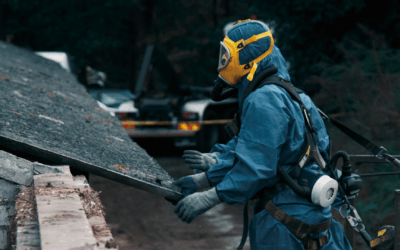The main types of asbestos roofing materials to be aware of
10 April, 2022Asbestos is not uncommon in older New Zealand homes, and can be found building materials used prior to the year 2000.
One area in which asbestos is particularly common is in roofing materials. That’s because asbestos is highly durable and fire resistant, which made it an excellent building material for outdoor spaces – before the dangers of asbestos poisoning were understood.
In New Zealand, we often discover asbestos in the roofing of older homes. Here are the main types of roofing materials that can include asbestos.
Cement sheets
Cement sheets have long been used as an affordable and practical option for roofing and siding on residential and commercial properties. They are also sometimes called corrugated cement sheets or super six sheets.
The asbestos makes the cement much more durable and easy to work with, but problems occur as over time, these sheets can crumble easily and release asbestos fibres into the environment.
If you have cement sheets on your property, it may be a good idea to have them checked for asbestos.
Decramastic roof tiles
Decramastic roof tiles are pressed metal tiles that were common before the 1980s in New Zealand. They are made in a curved scallop shape, and have a stone coating for added durability.
Unfortunately, many of them were made with asbestos. One survey found that asbestos was present in as much as 50% of metal roof tiles in New Zealand.
Today, it is best to take the approach that these tiles have asbestos in them until proven otherwise with testing.
While they are generally considered ‘safe’ if they remain in good condition, they can quickly become a hazard should they start to break or deteriorate, or if you complete any kind of work on them – even if that’s simply cleaning.
Not all builders and contractors are aware of the potential risks in these roof tiles, so it’s best to employ a specialist asbestos removal company to test and potentially remove these tiles safely ahead of any work you have planned.
Read more about asbestos roof materials in our case study:
Roofing shingles
Roofing shingles made from a combination of asbestos and hydraulic cement were very popular throughout the 20th century for their light-weight design, low cost, and durability.
Much like roofing riles and cement sheets, shingles don’t offer any obvious signs that they may contain asbestos.
Instead, best practice is to treat them as if they do until proven otherwise with professional asbestos testing.
Bitumen and membrane roofing
Bitumen and membrane roofing, or modified bitumen roofing, is another popular material, especially for flat roofs in commercial and industrial buildings.
It’s long lasting and great at stopping leaks due to its seamless design, and is highly durable against all kinds of weather.
Of course, some bitumen and membrane roofing materials were historically made with asbestos products, so older homes and properties man still contain it today.
Gutters and downpipes
One overlooked area when it comes to asbestos in roofing are the actual gutters and downpipes in New Zealand homes and businesses.
Much like other roofing materials, the addition of asbestos made some gutters and downpipes more durable, light-weight, and fireproof, making them an attractive option at the time.
The culprit here is cement fibre boarding, which gives gutters and downpipes a cement-like appearance, and means they could be hiding asbestos fibres.
Get your roof checked for asbestos with a specialist
PRO Environmental Services is a roof asbestos removal specialist. Our teams operate throughout Wellington and across the lower North Island and upper South Island, and work on residential, commercial, and industrial buildings.
If you’re unsure about what’s in your roofing materials, it’s best to have a professional inspection and asbestos testing done to determine the existence of asbestos and the condition of the materials.
Get in touch for a free, no-obligation quote to test for asbestos or remove asbestos from your roofing.
Related articles from our blog
Environmental Laws and Regulations: How They Protect the Planet
Environmental laws and regulations exist to keep both humans and the environment safe from hazardous materials. We follow them on every project, every time.
Asbestos Awareness Week: What you need to know
Asbestos Awareness Week is next month. Here are some important asbestos facts, tips on minimising your risk, and who to call if you need asbestos removal!
When to review your asbestos management plan
There are multiple scenarios under which you are required to review your asbestos management plan as your worksite’s PCBU. Read on to learn more.


